What is variance analysis?
Variance analysis is a key element of performance management and is the process by which the total difference between flexed standard and actual results is analysed.
A number of basic variances can be calculated. If the results are better than expected, the variance is favourable (F). If the results are worse than expected, the variance is adverse (A).
It is important to be able to:
- calculate a variance
- explain the meaning of the variance calculated
- identify possible causes for each variance.
Once the variances have been calculated, an operating statement can be prepared reconciling actual profit to budgeted profit, under marginal costing or under absorption costing principles.
Basic variances can be calculated for sales, material, labour,variable overheads and fixed overheads.
Each of these will be reviewed in turn
Sales variances
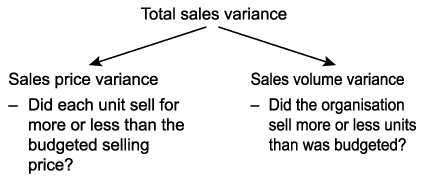
Calculation
A line by line approch gives the following:
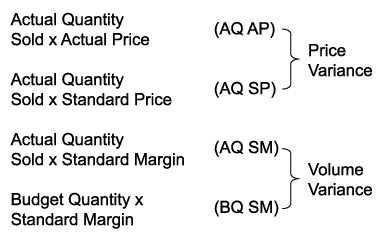
Note: 'Margin' = contribution per unit (marginal costing) or profit per unit (absorption costing).
| Causes of material variances |
| Variance |
Favourable |
Adverse |
| Material Price |
- Poorer quality materials
- Discount given for buying bulk
- Change to a cheaper supplier
- Incorrect budgeting
|
- Higher quality materials
- Change to a more expensive supplier
- Unexpected price increase encountered
- Incorrect budgeting
|
| Material Usage |
- Higher quality materials
- More efficient use of material
- Change is product specification
- Incorrect budgeting
|
- Poorer quality materials
- Less experienced staff using more materials
- Change is product specification
- Incorrect budgeting
|
Note: The material price variance and the material usage variance may be linked. For example, the purchase of poorer quality materials may result in a favourable price variance but an adverse usage variance.
Materials variances

Calculation

| Causes of material variances |
| Variance |
Favourable |
Adverse |
| Material Price |
- Poorer quality materials
- Discount given for buying bulk
- Change to a cheaper supplier
- Incorrect budgeting
|
- Higher quality materials
- Change to a more expensive supplier
- Unexpected price increase encountered
- Incorrect budgeting
|
| Material Usage |
- Higher quality materials
- More efficient use of material
- Change is product specification
- Incorrect budgeting
|
- Poorer quality materials
- Less experienced staff using more materials
- Change is product specification
- Incorrect budgeting
|
Note: The material price variance and the material usage variance may be linked. For example, the purchase of poorer quality materials may result in a favourable price variance but an adverse usage variance.
Material waste
Material waste may be a normal part of a process and could be caused by:
- evaporation
- scrapping
- testing
Waste would affect the material usage variance. Expected waste can be built into the standards used, so only excessive ("abnormal") waste would contribute towards the usage variance.
Labour variances
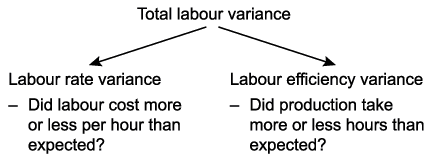
Calculation
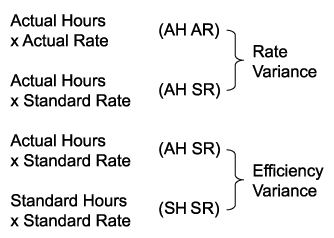
| Causes of labour variances |
| Variance |
Favourable |
Adverse |
| Labour rate |
- Lower skilled staff
- Cut in overtime/bonus
- Incorrect budgeting
|
- Higher skilled staff
- Increase in overtime/bonus
- Incorrect budgeting
- Unforeseen wage increase
|
| Labour efficiency |
- Higher skilled staff
- Improved staff motivation
- Incorrect budgeting
|
- Lower skilled staff
- Fall in staff motivation
- Incorrect budgeting
|
Note: The labour rate variance and the labour efficiency variance may be linked. For example, employing more highly skilled labour may result in an adverse rate variance but a favourable efficiency variance.
Idle time
Idle time occurs when employees are paid for time when they are not working e.g. due to machine breakdown, low demand or stockouts.
If idle time exists an idle time labour variance should be calculated.
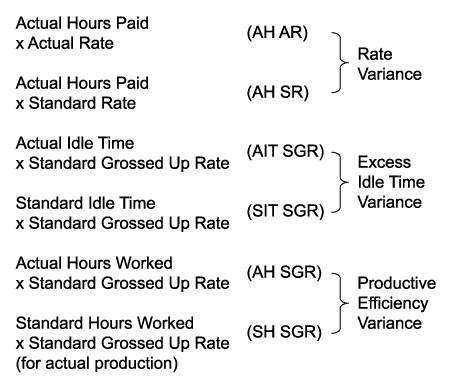
Controlling Idle time
Idle time can be prevented or reduced considerably by :
1. Proper maintenance of tools & machinery
2. Advanced production planning
3. Timely procurement of stores
4. Assurance of supply of power
5. Advance planning for machine utilisation
A consideration of labour variances can be extended to incorporate labour ratios as well.
Variable overhead variances
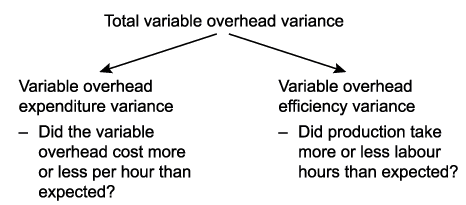
Calculation

|
Causes of variable overhead variances
|
| Variance |
Favourable |
Adverse |
| Var. o/h expenditure |
- Unexpected saving in cost of services
- More economic use of services
- Incorrect budgeting
|
- Unexpected increase in the cost of service
- Less economic use of service
- Incorrect budgeting
|
| Va. o/h efficiency |
|
|
Your FeedbackWe value your feedback on the topics or anything else you have found on our site, so we can make it even better.Give Feedback
Fixed overhead variances
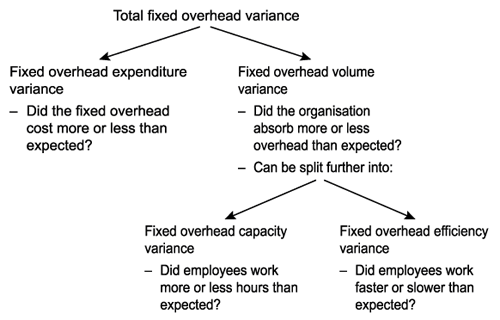
Marginal costing system
With a marginal costing profit and loss, no overheads are absorbed,the amount spent is simply written off to the income statement.
So with marginal costing the only fixed overhead variance is the difference between what was budgeted to be spent and what was actually spent, i.e. the fixed overhead expenditure variance.
Absorption costing system
Under absorption costing we use an overhead absorption rate to absorb overheads. Variances will occur if this absorption rate is incorrect (just as we will get over/under-absorption).
So with absorption costing we calculate the fixed overhead expenditure variance and the fixed overhead volume variance (this can be split into a capacity and efficiency variance).
Calculation
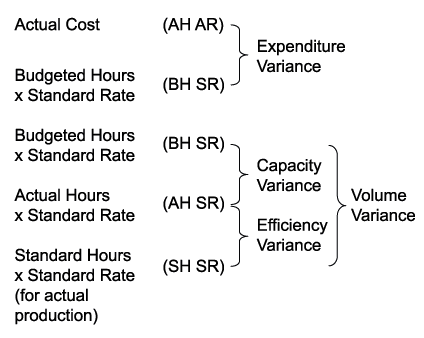
| Causes of fixed overhead variances |
| Variance |
Favourable |
Adverse |
| Fixed o/h expenditure |
- Decrease in price
- Seasonal effects
|
- Increase in price
- Seasonal effects
|
| Fixed o/h volume |
- Increase in production volume
- Increase in demand
- Change is productivity of labour
|
- Decrease in production volume
- Decrease in demand
- Production lost through strikes
|
| Fixed o/h capacity |
- Hours worked higher than budget
|
- Hours worked lower than budget
|
| Fixed o/h efficiency |
|
|
Operating statements
Operating statement under absorption costing
The purpose of calculating variances is to identify the different effects of each item of cost/income on profit compared to the expected profit. These variances are summarised in a reconciliation statement or operating statement.
Operating statement under absorption costing (AC)

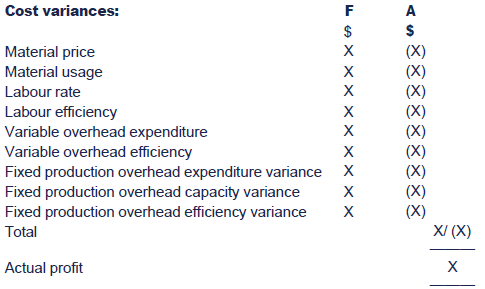
Operating statement under marginal costing
The operating statement under marginal costing is the same as that under absorption costing except;
-
a sales volume contribution variance is included instead of a sales volume profit variance
-
the only fixed overhead variance is the expenditure variances
-
the reconciliation is from budgeted to actual contribution then fixed overheads are deducted to arrive at a profit.
Operating statement under marginal costing (MC)
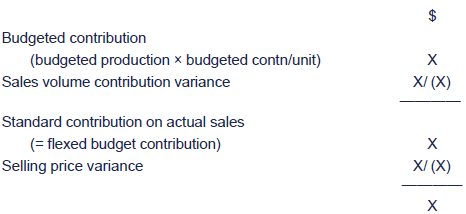
Variable cost variances:
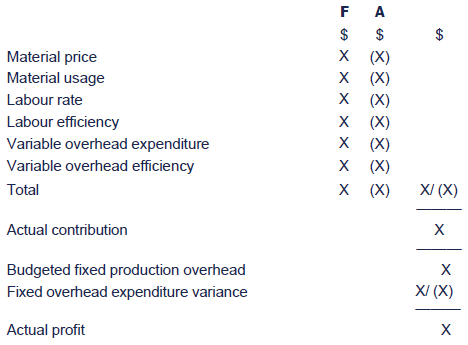
|
Created at 5/30/2012 4:37 PM by System Account
(GMT) Greenwich Mean Time : Dublin, Edinburgh, Lisbon, London
|
Last modified at 11/1/2016 11:46 AM by System Account
(GMT) Greenwich Mean Time : Dublin, Edinburgh, Lisbon, London
|
|
|
|
 |
Rating
:
|
 Ratings & Comments
(Click the stars to rate the page) Ratings & Comments
(Click the stars to rate the page)
|
 |
Tags:
|
|